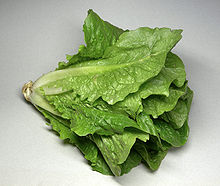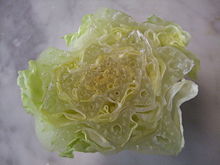- Romaine lettuce
-
Romaine or cos lettuce (Lactuca sativa L. var. longifolia) is a variety of lettuce which grows in a tall head of sturdy leaves with a firm rib down the center. Unlike most lettuces, it is tolerant of heat. The name cos lettuce derives from the Greek island of Kos, where it originated.[1]
Contents
Cuisine
The thick ribs, especially on the older outer leaves, should have a milky fluid which gives the romaine the typically fine-bitter herb taste.
Romaine is the usual lettuce used in Caesar salad.
Romaine is the usual lettuce in Middle Eastern cuisine.
Ritual use
Romaine lettuce may be used in the Passover Seder as a type of bitter herb, to symbolise the bitterness inflicted by the Egyptians while the Israelites were slaves in Egypt.
The day of 22 Germinal in the French Republican Calendar is dedicated to this lettuce.[2]
Nutrition
As with other dark leafy greens, the antioxidants contained within romaine lettuce are believed to help prevent cancer.[3] According to the 2011 edition of the Old Farmer's Almanac, the chlorophyll pigment in dark leafy greens, such as Romaine lettuce, may reduce levels of colon and liver cancer carcinogens.
Romaine lettuce Nutritional value per 100 g (3.5 oz) Energy 72 kJ (17 kcal) Carbohydrates 3.3 g - Dietary fibre 2.1 g Fat 0.3 g Protein 1.2 g Water 95 g Vitamin A equiv. 290 μg (36%) Folate (vit. B9) 136 μg (34%) Vitamin C 24 mg (29%) Calcium 33 mg (3%) Iron 0.97 mg (7%) Phosphorus 30 mg (4%) Potassium 247 mg (5%) Percentages are relative to US recommendations for adults.
Source: USDA Nutrient DatabaseNotes
- ^ Cos, Oxford Dictionaries
- ^ William Tooke, The Monarchy of France: its rise, progress, and fall, p. 634
- ^ American Institute for Cancer Research, "Foods That Fight Cancer: Dark Green Leafy Vegetables".
References
- Alan Davidson, The Oxford Companion to Food, s.v. lettuce. Oxford University Press 1999. ISBN 0-19-211579-0.
- John D. Kirschmann & Lavon J. Dunne, Nutrition Almanac, s.v. ISBN 0-07-034906-1.
Categories:- Leaf vegetables
- Vegetable stubs
Wikimedia Foundation. 2010.


